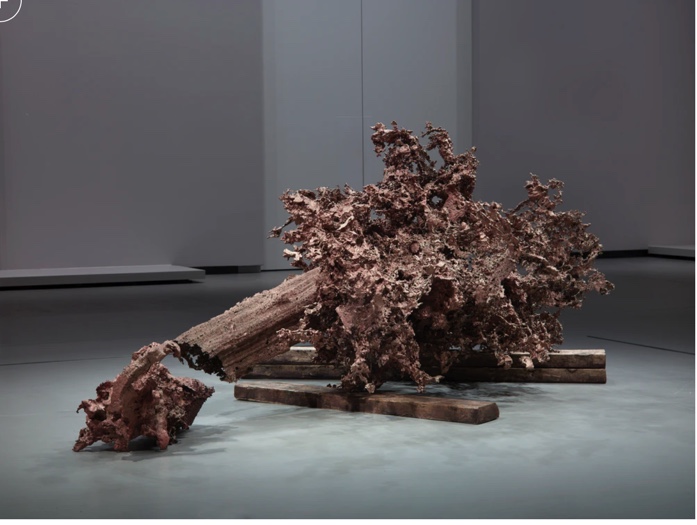Natalie Patterson
Professor Meiser
Matthew Barney Essay
Matthew Barney is a mixed media artist that derives drawings and sculptural works from his elaborately produced films. Known for his fascination with anatomy, anthropology, and nature, Barney created Water Cast 6: a sculptural work that serves as both a still, three-dimensional piece and a documentation of an action. Through a unique process of pouring metal into a combination of clay and water, Barney creates a sculpture that documents the path of the material weaving through the clay mixture. Upon first glance, the bronze sculpture appears delicate and fragile, yet the tone of the piece indicates a sense of natural power and sublime status. Without the information of how this sculpture came to be, one may assume it was formed by some kind of dangerous, quick pouring action.
The poured bronze sculpture is displayed over three planks of wood. Two of the pieces, longer than the third, are stacked on top of one another in parallel while the smaller third plank is placed at a slight angle. The angle of the plank adds to the rhythm of the sculpture by forcing the viewer’s vision towards the separated piece of bronze that sits flat on the floor of the gallery space. The main part of the bronze structure has a protruding tube-like section that further directs the viewer towards the separated small piece of bronze in a triangular fashion.
Created in 2015 and one of fourteen works in the series, this work, in particular, has several identifiable attributes. First, this work, although rather large in size reaching 130.8 x 200.7 x 299.7 cm, takes up a rather short rectangular block of space that is low to the ground in comparison to the viewer. This, in turn, enables the viewer to fully navigate the nooks and turns of the bronze without any optical issues like some that would occur if the sculpture took up more vertical height. Mirroring some kind of explosion, Barney displays this piece as a sculpture in the round rather than one meant to be shown against a wall. This further illustrates to the viewer that Barney intended for the viewers to inspect the entirety of the piece without facing obstacles.
Like many of Barney’s sculptural works, the idea of casting water into a sculpture followed a film of his titled, “River of Fundament” that also featured the collaboration of artist Jonathan Bepler. The film has a protagonist that reincarnates three times throughout the film into different bodies. Each time, the actor wakes up in a river of feces below a Brooklyn Heights apartment. With this pairing of the film’s narrative and the sculptural work, the viewer better comprehends the choice of bronze, a brown-toned metal, to represent the reincarnation into a river of feces. In particular, the smaller, separated part of the bronze is alluded to being birthed from the main component of the structure. In all, Barney’s work combines visual narrative with physical representations of a plot to intensify the viewer’s experience when viewing the works as a pair.
https://www.fondationlouisvuitton.fr/en/collection/artworks/water-cast-6
